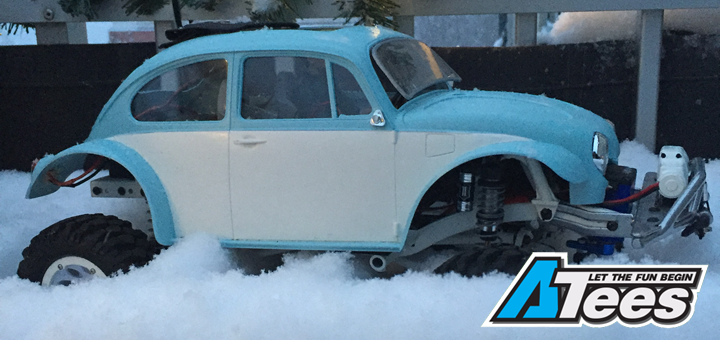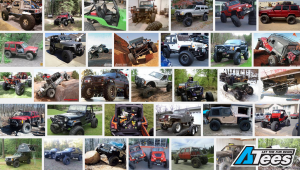Build Inspiration
I see a lot of custom builds, but for every custom build I see, I probably see 3 times more factory stock vehicles. Now there is nothing wrong with a factory stock vehicle and there are many cases where a factory stock vehicle can be better than a custom build. However, I get a lot of questions asking me where I get the ideas for my builds, how I get the info, where I do find it all and how do I create the entire "theme". The questions regarding the build inspiration are actually more frequent than the ones regarding the building techniques.
So where do we start?
For me, a build's inspiration can come from many different sources. To start off with I really like having unique builds when it comes to the look of the vehicle. I want to have something that nobody else has so my vehicle stands out from the crowd. This really drives what I do during the research and design phase.
One source of inspiration is other people's builds. I find builds on Instagram, Facebook and many different RC and 1:1 forums as well as magazines. Often one of these builds will really capture my attention and not let go. Other times I run into a 1:1 vehicle that does the same thing. So rather than simply copy someone else's build, I start looking online for other builds using the same base vehicle. I then work my way to something completely new by combining ideas that I have found on various vehicles, my own ideas and adding in my own customizations and style.
How can you do this?
It's not easy to jump into a custom build for the first time. There are a lot of potential problems that you can run into but the biggest can be just knowing where to start. First off you need to answer these two questions:
- Who is the build for?
- What will it be used for?
The first is pretty easy, if it's for you or someone else you need to go with what you or they like. But knowing what that is can be tricky. The second question is a bit harder. You need to figure out how and where the vehicle will be used. Is it a scale crawler, a competition crawler, a drifter, a racer, etc. Will it be used in a light way like a trail rig or hard like a competition vehicle?
For this example lets assume that you like Jeeps and you are into trailing. The next step would be to start looking at trailing rigs. To find them, you can search online through Google Images for things like "Jeep Trail Rigs". There are many great trailing locations around the world as well as many great Jeep forums so start searching them for photos of other trailing Jeep rigs. Then start to narrow down the specific things that make it exciting for you. Is it a particular model, a particular style of build (trailing, rock climbing, trophy racing, etc) or is it the color combinations or something else. Keep collecting images, saving them to your hard drive as you search and find things that you like. When you feel that you have enough items or you are starting to see repeats of the same features over and over, stop and take a look at what you've gathered.
Your collection of images should give you a good representation of what you like for this build. The next step is to combine those features into a list. Take the things that you like out of each picture and write them down. Now take a look at your list. It should be a pretty good representation of the build and if you notice major areas missing, go back and start looking at images again for that area. For example if you didn't mention anything about wheels and tires in your list, go looking for those on the type of Jeep you are going to build.
So far your list is a bunch of features that other people have already done on their Jeeps. It might be possible that nobody has the particular combination that you have created a list for, but in the Jeep world that's pretty unlikely. So the next step would be to customize the items in your list in various ways. Try to think about what you could do with the items to make them different. For example you can start with a color or color combination that isn't often used. Another option is how you would color coordinate the items in the build. The shock bodies could either match or contrast with the body color. Look at the other items in the list and see if there are things that you might need to connect two items together. Another example would be to come up with some sort of container to hold the scale accessories but mount it in a different or unusual way. You can also do a bit of cross-genre when it comes to accessories and style. For example a trailing rig often has some accessories to support you for a day or two at most, tools, water and gas containers and such. But you could take some items from a more extreme expedition style rig and have a built in tent that folds up or bigger containers for water and gas or a large cooler for food.
Now that you have your list of features it is finally time to go start looking at RC parts. You need to try to find the RC components that match up to the items in your list. It's also a good time to decide if you will go with a hard plastic body or if you will go with a lexan body. This again is where the "who it is for and how it will be used" comes into play. A lexan body is typically better for newer drivers as it is more forgiving to accidents and it is also cheaper. A hard plastic body has more detail and allows for things like full interiors much more easily.
What's next?
The final steps before ordering parts and the actual assembly is making sure that all of the RC parts that you found will work together. For example, if you are going with a hard plastic Jeep body and an Axial Racing SCX10 chassis you should make sure that the wheelbase of the SCX10 frame will fit the body. If the body's wheelbase is too short or too long, you will need to add new suspension links (like the ones from Boom Racing that are available in lengths from 15mm to 100mm in 5mm increments) to your build list to match the wheelbase on the chassis to the body. If you want a winch, make sure that the bumper you selected has a place to mount the winch or that you have a plan on how to modify it to mount the winch. There will be times you need to change your plans to make the parts work with each other or come up with a way to modify the parts to get what you want.
If everything on your list works well with each other and there are no other conflicts that you can't resolve, it's time to order your parts, wait (not so patiently) for the boxes and boxes of parts to arrive and then finally start building your new unique masterpiece!



[…] so you've gone through the Build Inspiration article and have your build planned, you've purchased the lexan body that will be the basis of […]